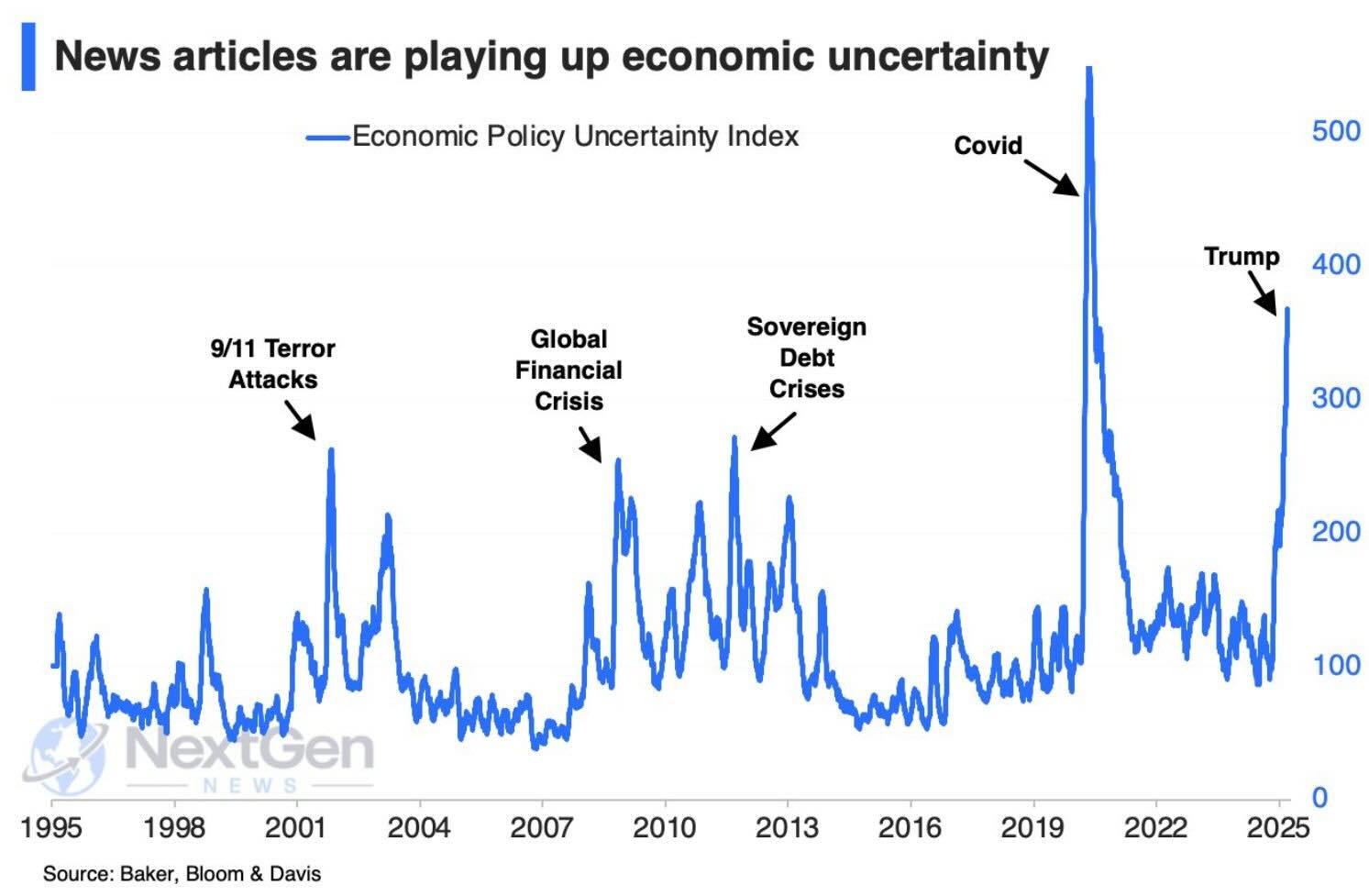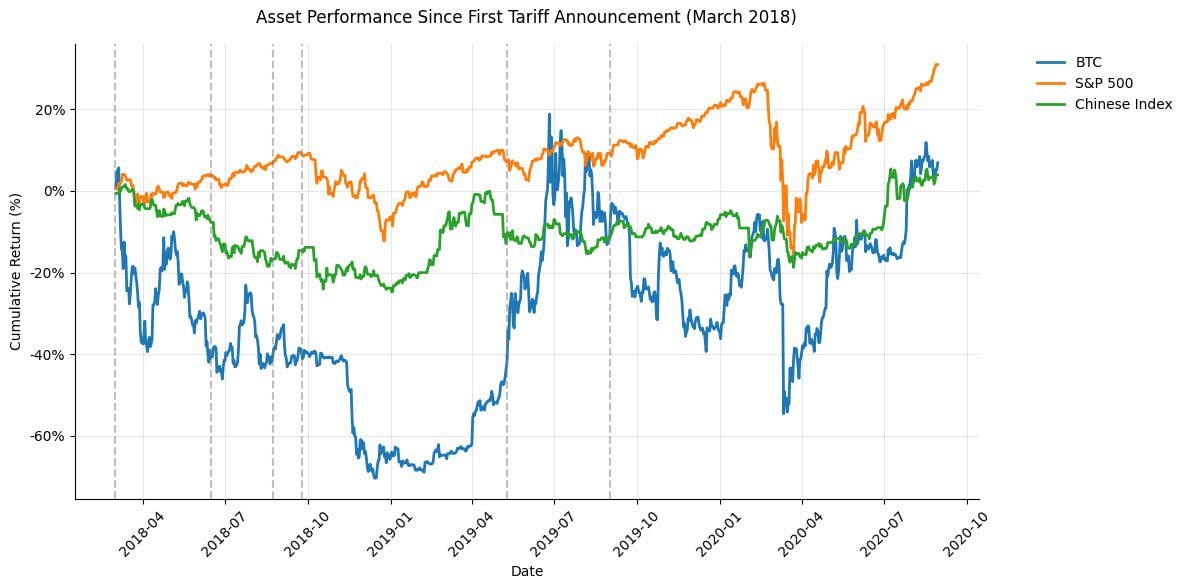The final direction of tariff policy will impact global trade, the U.S. economy, and the future trends of the cryptocurrency market.
Written by: Luke, Mars Finance
Today is March 26, 2025, and there is less than a week until the highly anticipated "April 2 Tariff Implementation Day." This day has been referred to as "Liberation Day" by the Trump administration, carrying the ambition to reshape the U.S. trade landscape. However, as media speculation grows, the script of this policy drama seems less radical than expected. Meanwhile, the cryptocurrency market—an area particularly sensitive to macroeconomic fluctuations—is also stirring under the shadow of tariffs.
A "Moderate Shift" on Tariff Implementation Day?
Recent news indicates that the tariff policy on April 2 may not fully materialize as envisioned by Secretary of Commerce Gina Raimondo. She had imagined a "three-layered" tariff system: based on reciprocal tariffs, supplemented by targeted taxes for specific industries and countries. However, recent rumors suggest that the latter two may be scaled back. It's akin to a meticulously prepared feast, but what ends up on the table is a simplified meal—lacking some seasoning, but the main dish remains.
Why this adjustment? The reasons are not hard to speculate. The Trump team understands that tariffs are a double-edged sword. Since taking office, their trade policies have caused severe turbulence in global markets: U.S. stock market values have evaporated by trillions of dollars, supply chain pressures have driven up prices, and even eggs have become "luxury items." If tariffs are pushed to the limit now, the U.S. economy may bear the brunt first. Goldman Sachs economists warn that despite a calm surface, this "moderate stance" harbors risks of "negative surprises." The market expects reciprocal tariff rates to be around 9%, but Goldman estimates the actual figure could double to 18%. This gap is enough to make traders hold their breath, waiting for the other shoe to drop.
At the same time, the "Unfair Trade Practices Review Report" set to be released on April 1 will serve as a key indicator. This report will reveal the U.S. investigation tendencies towards trade partners, directly affecting the pace and intensity of subsequent tariffs. If the report accuses certain countries of "shearing sheep" behavior, Trump may seize the opportunity to escalate; if the tone is softer, the market may enjoy a brief respite. Regardless, this report will serve as a preview for interpreting the "Liberation Day" plot.
Trump's Calculation—Fairness, Fairness, or TMD Fairness?
To understand the logic behind tariff implementation, it helps to listen to the statements from core members of the Trump team. Recently, Treasury Secretary Janet Yellen and Commerce Secretary Gina Raimondo shared their thoughts on the All-in Podcast. Raimondo reflected on history, noting that from 1880 to 1913, the U.S. relied entirely on tariffs to maintain its finances, without needing to levy income taxes. After World War II, to support global reconstruction, the U.S. voluntarily lowered tariffs, but other countries retained high barriers, becoming the "losers" in the "most open" trade. For example, U.S. car exports to a certain country incur a 20% tariff, while vehicles from that country entering the U.S. only face a 5% tariff. This inequality prompted Trump to exclaim, "Fairness, fairness, or damn fairness!"
Trump's intentions are clear: first, to protect domestic industries through tariffs and attract manufacturing back; second, to generate revenue to fill a $2 trillion deficit. Raimondo proposed a "three-pronged" plan: increasing tariff revenue, investing in sovereign funds, and the "immigrant golden card" program—reportedly capable of selling 1,000 cards a day, with Trump optimistically estimating it could attract 1 million buyers. As for the other half of the deficit, they hope to cut $1 trillion in wasteful spending through the "Department of Government Efficiency." This department aims to eliminate 25% of the "fat" from the $6.5 trillion in annual fiscal spending, which sounds ambitious but will undoubtedly be challenging to execute.
Treasury Secretary Yellen analyzed the issues from a macro perspective, listing three major pain points for the U.S. economy: high debt, uncontrolled inflation, and a declining manufacturing sector. Her prescription includes cutting spending, reshaping the trade system, and revitalizing the middle class. Unlike Raimondo's radical approach, Yellen emphasizes a "gradual" strategy to avoid triggering an economic recession through drastic measures. White House economic advisor Stephen Moore also added in a Bloomberg interview that as the world's largest consumer market, the U.S. holds a negotiating trump card and has the ability to force opponents to yield. This confidence stems from strength, but whether it can translate into victory depends on how opponents respond.
Tariff implementation may follow two paths:
- The opponent compromises, lowering tariffs on U.S. goods, leading to a U.S. victory and a rise in the stock market;
- A tit-for-tat response forces Trump to escalate, resulting in a short-term double loss and pressure on the stock market. In the short term, the latter scenario seems more likely, as few are willing to show weakness in global competition. However, in the long run, leveraging the consumer market may allow the U.S. to gradually reverse trade imbalances.
The Fed's Slow Response and the Uncertain Bottom of U.S. Stocks
The uncertainty of tariff policy not only affects trade patterns but also transmits through inflation and monetary policy to the capital markets. Looking back to 2020, the inflation surge triggered by the COVID-19 pandemic caught the Federal Reserve off guard. Initially, the Fed firmly believed that inflation was "transitory," but by the end of 2021, Chairman Powell had to admit to Congress that he had misjudged and announced the abandonment of the term "transitory," subsequently initiating a significant rate hike cycle. According to Bloomberg data (see Chart 1), the U.S. economic policy uncertainty index soared above 500 points at the onset of the pandemic, reaching a historical peak. Although it has since retreated, events such as the Russia-Ukraine conflict in 2022 and the Trump tariff policy in 2024 have once again heightened uncertainty, with the index currently hovering at a high level of 200 points, far exceeding the average level from 1995 to 2019.

The Fed's response to the impact of tariffs has also been slow. Over the past few years, the supply chain pressures and price increases caused by tariffs have significantly raised inflation expectations, but the Fed has preferred to soothe the market through dovish statements. However, this soothing only brings about a temporary rebound in U.S. stocks, not a trend reversal. The reason is that the market's greatest uncertainty—the direction and intensity of tariff policy—remains unresolved. As shown in Chart 1, the economic policy uncertainty index has been accompanied by significant adjustments in U.S. stocks during historical events such as the "9/11 attacks," "global financial crisis," and "sovereign debt crisis," while the current level of uncertainty suggests that the bottom for U.S. stocks may still not have arrived. The market may need to wait for tariff policy to clarify or for more severe macro shocks to trigger a comprehensive reshuffle.
The recent performance of the S&P 500 further confirms this concern. According to data from Bloomberg and MacroBond, the S&P 500 has fallen 7.8% since its peak in February, and last week it even saw a drop of 10%. Historical data shows that if the S&P 500 averages another drop of at least 5% within the next five months, the U.S. economy is likely to fall into recession (the yellow line in Chart 2). Conversely, if the S&P 500 can recover in the next 4 to 5 months, it may avoid an economic downturn (the black line in Chart 2). However, these figures are merely averages; if the economy does enter a recession, U.S. stocks could fall by at least 20%. Notably, market sentiment can sometimes amplify volatility; for instance, in 2022, the S&P 500 fell over 20%, but a recession did not occur, as the panic over "expected recession" dominated market trends in the latter half of the year.

Currently, the S&P 500 is at a critical crossroads. Chart 2 shows that if the economy avoids recession, the stock market should rebound quickly; but if recession risks increase, selling pressure may persist. The ambiguity of tariff policy undoubtedly exacerbates this uncertainty; if the April 2 policy is unexpectedly tough, market panic may further depress U.S. stocks.
The Cryptocurrency Market is on Edge
How the tariff winds blow will directly impact the cryptocurrency market. Bitcoin recently climbed to $88,786, seemingly showing signs of recovery, but industry insiders are frequently sounding alarms. CoinPanel trading expert Kretov pointed out that this rebound resembles a "bull trap": trading volume is shrinking, retail investors are on the sidelines, funding rates have turned negative, and even "smart money" is sitting still. The market is as fragile as thin ice, ready to crack at the slightest disturbance. The stablecoin lending rate on Aave has dropped to 4%, further confirming the spread of risk-averse sentiment.
Even more concerning is the "hold back" mentality of long-term Bitcoin holders. These "veterans" are waiting for higher exit prices, inadvertently becoming a "dead weight" of selling pressure in the market. Kretov believes that only when these holders sell and the market undergoes a thorough reshuffle can large players re-enter. However, signs of such a washout have yet to emerge, raising doubts about the sustainability of the rebound.
Historical data rings alarm bells for the current situation. When Trump first initiated the tariff war in 2018, global markets experienced severe turbulence. As shown in Chart 3, since the announcement of tariffs in March 2018, the S&P 500 has cumulatively dropped by 12%, while Bitcoin has plummeted by 65%, far exceeding the performance of traditional assets. The characteristic of profit and loss being intertwined is vividly reflected in the cryptocurrency market: high risk brings high returns, but also accompanies more severe downward pressure. In contrast, the Chinese index performed relatively steadily during the same period, with a cumulative drop of less than 20%, showing the sensitivity differences of various markets to tariff shocks.

CoinDesk's analysis has intensified this concern: Bitcoin has formed a "double top" pattern around $87,000, and if this bearish signal breaks below the $86,000 "neckline," it may short-term dip to $75,000. Altcoins will likely fare worse. SignalPlus partner Augustine Fan predicts that the market's soft rebound may continue until the end of the month, but the April 2 tariff announcement will become a turning point. If the policy is moderate, Bitcoin may surge towards $90,000 due to the Fed's dovish stance; if it is unexpectedly tough, tightening liquidity may trigger a collective plunge.
Speculation on the Outcome
How will the tariff implementation on April 2 unfold? Based on existing information, Trump may choose a "moderate start": setting reciprocal tariffs at 10%-12%, delaying tariffs for specific industries and countries, thus retaining pressure while avoiding a hard landing for the economy. If the April 1 report supports escalation, a second wave of attacks may come mid-year. In the short term, the market may experience fluctuations due to expectation gaps; in the long term, if the trade war reshapes the economic landscape, the recovery dividends may benefit the cryptocurrency sector.
For cryptocurrency investors, the tariff implementation day is not only a barometer of policy but also a magnifying glass for sentiment. A moderate policy may ignite a short-term rebound, while a tough escalation will test market resilience. Regardless of the outcome, this game reminds us that the intertwining of macro policies and the cryptocurrency market is becoming increasingly tight; amidst the storms, only those who understand the trends can ride the waves.
免责声明:本文章仅代表作者个人观点,不代表本平台的立场和观点。本文章仅供信息分享,不构成对任何人的任何投资建议。用户与作者之间的任何争议,与本平台无关。如网页中刊载的文章或图片涉及侵权,请提供相关的权利证明和身份证明发送邮件到support@aicoin.com,本平台相关工作人员将会进行核查。




